In this article, we’ll delve into six captivating case studies that showcase the power of intelligent building technologies in revolutionizing the way we live, work, and interact with our built environment. Let’s explore these cutting-edge examples and uncover the data and facts behind their success.
Case Study 1: The Edge, Amsterdam, Netherlands:
The Edge, an iconic smart office building, boasts an impressive array of sustainable features. With over 28,000 sensors collecting data, it optimizes energy consumption, achieving a staggering 70% reduction compared to traditional buildings. Its integrated solar panels generate more electricity than the building requires, making it energy-positive. Furthermore, the Edge’s advanced occupancy and temperature sensors ensure personalized comfort for each occupant.

Case Study 2: One Angel Square, Manchester, United Kingdom:
One Angel Square, the Co-operative Group’s headquarters, is a marvel of intelligent design. Equipped with a comprehensive building management system, it uses real-time data to monitor and control various systems, resulting in a 50% reduction in energy usage. Its sophisticated natural ventilation system, combined with efficient lighting and insulation, contributes to a healthier indoor environment and a significant decrease in carbon emissions.

Case Study 3: Pixel, Melbourne, Australia:
Pixel, a sustainable development in Melbourne, integrates cutting-edge technologies for enhanced energy efficiency. The building utilizes a centralized control system to manage lighting, heating, and cooling, resulting in a remarkable 30% reduction in energy consumption. Its intelligent façade adjusts to external conditions, optimizing natural light and reducing the need for artificial lighting.

Case Study 4: Iconic Tower, Seoul, South Korea:
The Iconic Tower in Seoul is a shining example of how intelligent buildings shape the urban landscape. Its advanced building automation system not only ensures efficient energy management but also enhances security and occupant comfort. Real-time monitoring of energy usage enables proactive optimization, leading to a 25% reduction in energy consumption and substantial cost savings.

Case Study 5: Bank of America Tower, New York City, USA:
The Bank of America Tower in New York City showcases the power of intelligent buildings on a grand scale. With features like state-of-the-art air filtration systems, occupancy sensors, and advanced water conservation measures, it achieved LEED Platinum certification and became one of the most energy-efficient skyscrapers in the world. The tower’s intelligent lighting system saves an estimated 70% on lighting energy.

Case Study 6: Digital Beijing Building, Beijing, China:
The Digital Beijing Building demonstrates how intelligent buildings can support sustainable urban development. Equipped with a comprehensive smart building management system, it monitors and controls various aspects of its operations, including energy usage, security, and maintenance. The building’s integrated approach to data analytics and automation optimizes energy efficiency and reduces operational costs.

The world of intelligent buildings is brimming with innovation, efficiency, and sustainability. These six captivating case studies provide a glimpse into the immense potential of intelligent building technologies. From significant energy savings and carbon footprint reduction to enhanced occupant comfort and well-being, these intelligent buildings are shaping a greener and smarter future.
IntelligentBuildings #Sustainability #buildingmanagementsystems #smartbuildings #buildingautomation #bms #HVAC


0 Comments